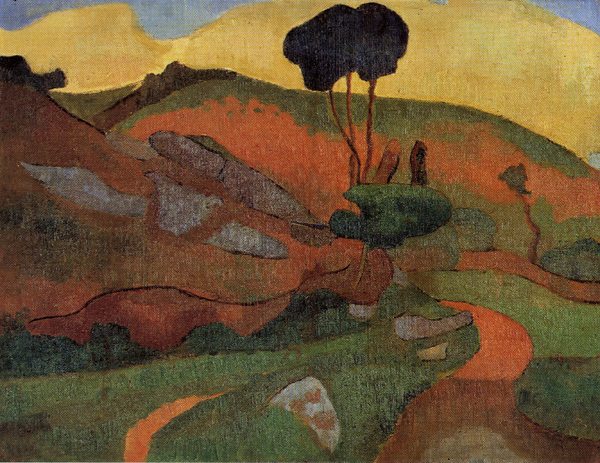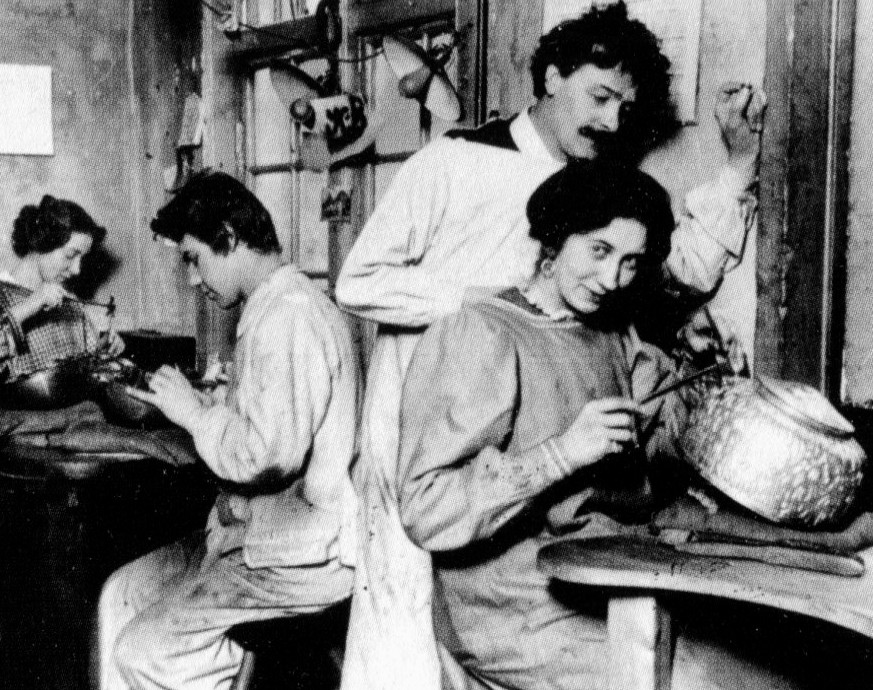|
Mogens Ballin
Mogens Ballin (20 March 1871, Copenhagen – 27 January 1914, Hellerup) was a Danish artist, one of a group of painters who gathered in the Breton village of Pont-Aven. He later became a notable silversmith designing jewelry and lamps.Jørn Otto Hansen, "Mogens Ballin" ''Kunstindeks Danmark og Weilbachs Kunstnerleksikon''. Retrieved 10 May 2012. Biography Ballin came from a well-to-do Jewish family in Copenhagen. Of particular importance to his future were the French lessons he had with 's wife, Mette, in |
Mogens Ballin
Mogens Ballin (20 March 1871, Copenhagen – 27 January 1914, Hellerup) was a Danish artist, one of a group of painters who gathered in the Breton village of Pont-Aven. He later became a notable silversmith designing jewelry and lamps.Jørn Otto Hansen, "Mogens Ballin" ''Kunstindeks Danmark og Weilbachs Kunstnerleksikon''. Retrieved 10 May 2012. Biography Ballin came from a well-to-do Jewish family in Copenhagen. Of particular importance to his future were the French lessons he had with 's wife, Mette, in |
Abstract Art
Abstract art uses visual language of shape, form, color and line to create a composition which may exist with a degree of independence from visual references in the world. Western art had been, from the Renaissance up to the middle of the 19th century, underpinned by the logic of perspective and an attempt to reproduce an illusion of visible reality. By the end of the 19th century many artists felt a need to create a new kind of art which would encompass the fundamental changes taking place in technology, science and philosophy. The sources from which individual artists drew their theoretical arguments were diverse, and reflected the social and intellectual preoccupations in all areas of Western culture at that time. Abstract art, non-figurative art, non-objective art, and non-representational art are all closely related terms. They have similar, but perhaps not identical, meanings. Abstraction indicates a departure from reality in depiction of imagery in art. This departure ... [...More Info...] [...Related Items...] OR: [Wikipedia] [Google] [Baidu] |
Danish Male Painters
Danish may refer to: * Something of, from, or related to the country of Denmark People * A national or citizen of Denmark, also called a "Dane," see Demographics of Denmark * Culture of Denmark * Danish people or Danes, people with a Danish ancestral or ethnic identity * A member of the Danes, a Germanic tribe * Danish (name), a male given name and surname Language * Danish language, a North Germanic language used mostly in Denmark and Northern Germany * Danish tongue or Old Norse, the parent language of all North Germanic languages Food * Danish cuisine * Danish pastry, often simply called a "Danish" See also * Dane (other) * * Gdańsk * List of Danes * Languages of Denmark The Kingdom of Denmark has only one official language, Danish, the national language of the Danish people, but there are several minority languages spoken, namely Faroese, German, and Greenlandic. A large majority (about 86%) of Danes also s ... {{disambiguation Language and nation ... [...More Info...] [...Related Items...] OR: [Wikipedia] [Google] [Baidu] |
Post-impressionist Painters
Post-Impressionism (also spelled Postimpressionism) was a predominantly French art movement that developed roughly between 1886 and 1905, from the last Impressionist exhibition to the birth of Fauvism. Post-Impressionism emerged as a reaction against Impressionists' concern for the naturalistic depiction of light and colour. Its broad emphasis on abstract qualities or symbolic content means Post-Impressionism encompasses Les Nabis, Neo-Impressionism, Symbolism, Cloisonnism, the Pont-Aven School, and Synthetism, along with some later Impressionists' work. The movement's principal artists were Paul Cézanne (known as the father of Post-Impressionism), Paul Gauguin, Vincent van Gogh and Georges Seurat. The term Post-Impressionism was first used by art critic Roger Fry in 1906.Peter Morrin, Judith Zilczer, William C. Agee, ''The Advent of Modernism. Post-Impressionism and North American Art, 1900-1918'', High Museum of Art, 1986 Critic Frank Rutter in a review of the Salon d'Automne ... [...More Info...] [...Related Items...] OR: [Wikipedia] [Google] [Baidu] |
19th-century Danish Painters
The 19th (nineteenth) century began on 1 January 1801 ( MDCCCI), and ended on 31 December 1900 ( MCM). The 19th century was the ninth century of the 2nd millennium. The 19th century was characterized by vast social upheaval. Slavery was abolished in much of Europe and the Americas. The First Industrial Revolution, though it began in the late 18th century, expanding beyond its British homeland for the first time during this century, particularly remaking the economies and societies of the Low Countries, the Rhineland, Northern Italy, and the Northeastern United States. A few decades later, the Second Industrial Revolution led to ever more massive urbanization and much higher levels of productivity, profit, and prosperity, a pattern that continued into the 20th century. The Islamic gunpowder empires fell into decline and European imperialism brought much of South Asia, Southeast Asia, and almost all of Africa under colonial rule. It was also marked by the collapse of the large S ... [...More Info...] [...Related Items...] OR: [Wikipedia] [Google] [Baidu] |
Georg Jensen
Georg Arthur Jensen (31 August 1866 in Rådvad – 2 October 1935 in Copenhagen) was a Danish silversmith and founder of Georg Jensen A/S (also known as Georg Jensen Sølvsmedie). Early life Born in 1866, Jensen was the son of a knife grinder in the town of Raadvad, just to the north of Copenhagen. Jensen began his training in goldsmithing at the age of 14 in Copenhagen. His apprenticeship with the firm Guldsmed Andersen, ended in 1884, and this freed Georg to follow his artistic interests. In 1884 he became a journeyman and in 1887 he enrolled at the Royal Danish Academy of Fine Arts (Kongelige Danske Kunstakademi), where he studied sculpture with Theobald Stein. He graduated in 1892 and began exhibiting his work. After graduation he started studying ceramics with Joachim Petersen (1870–1943). Although his ceramic sculptures was well received, making a living as a fine artist proved difficult and he turned his hand to the applied arts. First as a modeller at the Bing & ... [...More Info...] [...Related Items...] OR: [Wikipedia] [Google] [Baidu] |
Art Nouveau
Art Nouveau (; ) is an international style of art, architecture, and applied art, especially the decorative arts. The style is known by different names in different languages: in German, in Italian, in Catalan, and also known as the Modern Style (British Art Nouveau style), Modern Style in English. It was popular between 1890 and 1910 during the Belle Époque period, and was a reaction against the academic art, eclecticism and historicism of 19th century architecture and decoration. It was often inspired by natural forms such as the sinuous curves of plants and flowers. Other characteristics of Art Nouveau were a sense of dynamism and movement, often given by asymmetry or whiplash lines, and the use of modern materials, particularly iron, glass, ceramics and later concrete, to create unusual forms and larger open spaces.Sembach, Klaus-Jürgen, ''L'Art Nouveau'' (2013), pp. 8–30 One major objective of Art Nouveau was to break down the traditional distinction between fine ... [...More Info...] [...Related Items...] OR: [Wikipedia] [Google] [Baidu] |
Jens Ferdinand Willumsen
Jens Ferdinand Willumsen (7 September 1863 – 4 April 1958) was a Danish painter, sculptor, graphic artist, architect and photographer. He became associated with the movements of Symbolism and Expressionism. Biography J. F. Willumsen was born in Copenhagen, Denmark. He was the son of Hans Willumsen and Ane Kirstine. He was initially trained in art at the Royal Danish Academy of Fine Arts from 1881 to 1885 and in architecture at the Copenhagen Technical College from 1879 to 1882. He completed his education in 1885 with the artists P.S. Krøyer (1851-1909) and Laurits Tuxen (1853–1927). His works were exhibited in the Paris Salon, the Société Nationale des Beaux-Arts, the Société des Artistes Indépendants, the art gallery of Le Barc de Boutteville and at the Exposition Universelle (1900). He was employed from 1897 to 1900 as an artistic director at the porcelain factory Bing & Grøndahl. Besides painting, Willumsen had interests in sculpture, architecture, ceramics, a ... [...More Info...] [...Related Items...] OR: [Wikipedia] [Google] [Baidu] |
Siegfried Wagner (sculptor)
Siegfried Wagner (13 April 1874 1 August 1952) was a Danish sculptor. Early life and education Wagner was born to Jewish–Danish parents on 13 April 1874 in Hamburg. His father was plumber Joseph Meyer Wagner and his mother was Julie Philipsen. He was adopted by his uncle Julius Jacob Heine and Frederikke Wagner in 1892. The family lived in Kongens Lyngby, Denmark. Wagner attended the Royal Danish Academy of Fine Arts in 1889–96. He worked for some time in Vilhelm Bissen's studio and under J.F. Willumsen at Bing & Grøndahl. Wagner worked as a teacher at Tegne- og Kunstindustriskolen for Kvinder in 1898–1900. He married Olga Wagner in 1899. Career Wagner and Mogens Ballin created a metal workshop in Copenhagen in 1900. In May 1902, Wagner created approximately 65 designs before leaving the workshop in 1902 to assume a position as artistic director of Tvermoes & Abrahamsen's Chandelier Factory. Wagner was represented at Den Frie Udstilling from 1905. He won the Grand P ... [...More Info...] [...Related Items...] OR: [Wikipedia] [Google] [Baidu] |
Johannes Jørgensen
Jens Johannes Jørgensen (6 November 1866, in Svendborg – 29 May 1956) was a Danish writer, best known for his biographies of Catholic saints. He was nominated for the Nobel Prize in Literature five times. Early days Johannes Jørgensen was born in 1866 in Svendborg, Denmark. In 1884, he travelled to Copenhagen to start his studies, but he quit his studies in 1888. In Copenhagen he began to develop radical social views, which soon led him into a circle of cultural and radical artists. He was fascinated by the Russian nihilists and by Georg Brandes who boasted of dispelling "the darkness of Christianity." He led a life of pleasure and married, but his happiness did not last. New voices announcing spiritual values were then being heard in Denmark. Jørgensen read Joris-Karl Huysmans, Maurice Maeterlinck and others. He broke with Georg Brandes and his school, which would later cause his ruin. The young poet From his earliest years, he had shown a strong love of poetry throug ... [...More Info...] [...Related Items...] OR: [Wikipedia] [Google] [Baidu] |







.jpg)